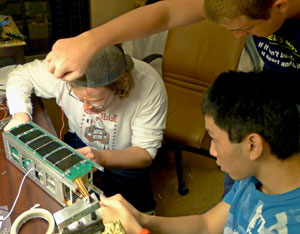
A nanosatellite designed by a team of University of Hawaiʻi at Mānoa electrical and mechanical engineering students is 1 of 33 selected to fly as auxiliary cargo on National Aeronautics and Space Administration missions planned during 2013 and 2014. This is the second year in a row that NASA has selected a nanosatellite from the College of Engineering’s Small-Satellite Program.
Both UH Mānoa nanosatellites are named Hoʻoponopono (to make right), in accordance with their mission of providing calibration for radar stations around the world.
Both nanosatellites take the form of a so-called CubeSat, which is about the size of a loaf of bread. The first CubeSat Hoʻoponopono 2, which was selected last year and is manifested for an upcoming NASA launch, is intended to be a demonstration mission lasting less than a year. The second CubeSat Hoʻoponopono 3 will incorporate lessons learned from the first mission, and placed in longer-lasting orbit.
For this year’s competition, NASA received 43 proposals for its CubeSat Launch Initiative. Hoʻoponopono 3 was ranked 6 on NASA’s priority list.

Small-Satellite Program
More than 200 students have participated in the UH Mānoa Small-Satellite Program, which recently celebrated its 10th anniversary.
“Small satellites aren’t just enablers of new technologies and systems,” said Professor of Electrical Engineering Wayne Shiroma. “They’re enabling a whole new generation of students for whom traditional educational methods don’t seem to work. These students find open-ended, discovery-based, group learning to be more effective than the traditional blackboard-and-textbook educational paradigm.”
The students have helped write proposals that have resulted in over $1 million in extramural funding and four launches. They also contributed to numerous publications including the first book on educational CubeSats and have pursued advanced degrees and careers in the space industry.
“Small-satellite project-based learning not only emphasizes the multidisciplinary aspect of engineering, but also integrates life experiences that result in a different kind of engineer that is more adaptable in today’s rapidly changing work environment.”

